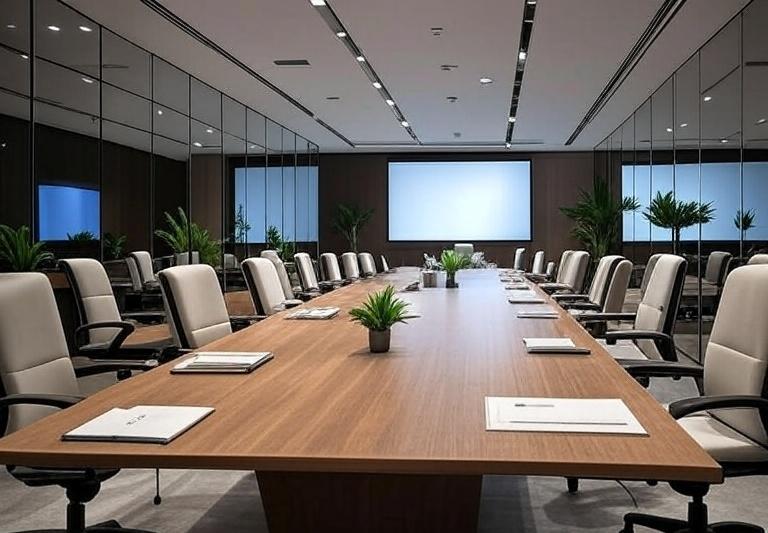
Mirror cladding is increasingly popular in modern commercial interiors, transforming ordinary spaces into brighter, more open, and visually striking environments. By covering walls, ceilings, or columns with mirror wall panels, businesses can create an illusion of space, improve natural light flow, and achieve a sleek, contemporary aesthetic.
But where does it work best in commercial settings? In this guide, we’ll explore the benefits, applications, design tips, and pros and cons of mirror cladding, helping you decide where and how to use it in your business interiors.
Why is Mirror Cladding Used in Commercial Spaces?
1. Illusion of space: Perfect for smaller commercial interiors, corridors, or enclosed areas where space feels limited.
2. Light reflection: Brightens up darker spaces without costly structural changes.
3. Modern aesthetics: Delivers a polished, high-end finish that enhances brand perception.
4. Durability: With professional installation and safety glass options, mirror cladding is long-lasting, easy to maintain, and compliant with commercial safety standards.
Best Places to Use Mirror Cladding in Commercial Interiors
1. Office Reception Areas
Reception sets the tone for clients and visitors. Mirror wall panelling in reception areas creates a welcoming, professional first impression, while reflecting natural or artificial light to keep the space bright and open. For businesses, combining mirror cladding in commercial interiors with branded signage or logos enhances identity and impact.
Learn More: Mirror Wall Panelling / Cladding
2. Conference and Meeting Rooms
Meeting rooms often lack natural light and can feel enclosed. Mirror cladding helps expand the perceived space while complementing glass partitions for a contemporary, open look. Acoustic mirror cladding can also be integrated to improve privacy while maintaining style.
3. Retail Stores and Showrooms
For retailers, mirror cladding does more than look good, it actively boosts sales by showcasing products. Mirrors highlight displays, expand visual depth in compact units, and enhance the shopping experience.
This is especially effective in fashion, jewellery, and luxury retail, where presentation is everything. Ceiling mirror cladding in showrooms also helps reflect lighting onto products for maximum visibility.
Related Read: What is a Mirror Cladding
4. Hotels and Hospitality Spaces
Hotels frequently use mirror cladding in lobbies, dining areas, and hallways to add sophistication and light. Ceiling mirror cladding in banquet halls or ballrooms can amplify chandeliers and natural lighting, creating a luxurious guest experience. Hotel mirror cladding also works well in corridors, making them appear wider and less confined.
5. Gyms, Spas, and Wellness Centres
In gyms and yoga studios, large mirror walls are essential for form and technique. Mirror cladding also makes compact studios feel larger, while moisture-resistant finishes ensure long-term durability. Spas and wellness centres use mirror wall cladding to reflect calming lighting and enhance relaxation.
Explore our upcoming guide on How Mirror Cladding is Installed for maintenance and durability tips.
6. Restaurants, Bars, and Cafés
Mirror cladding is often used to create ambience in dining spaces. From feature walls to behind serving counters, restaurant mirror cladding enhances atmosphere by reflecting lighting and décor. Ceiling cladding in bars and lounges can add a touch of glamour for evening service.
Design Tips for Effective Mirror Cladding Use
1. Choose between full-wall cladding or accent features depending on space.
2. Pair with neutral colours or textured materials for balance.
3. Avoid overuse of cladding to prevent overwhelming reflections, use it to highlight key spaces.
4. Opt for safety glass mirror cladding in high-traffic commercial areas such as gyms, retail, and hospitality settings.
Pros and Cons of Mirror Cladding in Commercial Interiors
| Pros | Cons |
| Enhances natural light and sense of space | Requires professional installation for safety |
| Adds a premium, modern finish to interiors | May require anti-shatter backing for compliance |
| Low maintenance and durable with proper sealing | Overuse can create distracting reflections |
Final Thoughts
Mirror cladding isn’t just an aesthetic upgrade—it’s a functional design solution that improves space, light, and ambience across commercial interiors. From office receptions and retail stores to hotels, gyms, and restaurants, its versatility makes it a popular choice across sectors.
If you’re considering mirror wall panels vs. mirror cladding, need installation advice, or planning to use mirror cladding in your commercial project, explore our Mirror Cladding Cost in the UK guide to budget effectively before getting started.
FAQs
Yes, when installed with safety glass and backing materials, it meets commercial safety standards.
.
Absolutely. It’s often used in hotels, restaurants, and lobbies to reflect light and create dramatic effects.
Indirectly, yes. By reflecting natural and artificial light, it reduces the need for extra lighting.
Unlike plain panels, mirror cladding adds functionality (light and depth) along with aesthetics.
Yes, provided it’s installed with moisture-resistant materials and proper sealing.
Yes, options include tinted finishes, shapes, and etched branding to align with interior themes.













